

BORIS PLOTNIKOV
ON DIALECTICAL STRUCTURE CREATING PROCESS
IN SHOSTAKOVICH'S PRELUDE OP. 34 # XX
This text is an attempt, firstly, to demonstrate how profoundly Shostakovich's innovations can penetrate into innermost depth of classic idiom and, secondly, to present an experience in blending three analytic methods: the "school" traditional approach, semiotics influenced fundamental immanent analysis1, and Schenkerian graphic techniques.
Prelude in C-sharp minor is very popular. Performers and listeners prefer it to others obviously because of its "democratic" roots ascending to Russian town song romantic tradition. Its manifestation, a generic sign can be heard in how calmly the melody unfolds over tonic triad prolonged in guitar-like texture of accompaniment. Through the whole first phrase we hear sustained tonic decorated with neighboring tones. The illusory simplicity is closely associated with "domestic" unpretentious, sincere mode of making music.
At a glance, its structure is very simple too: a typical romantic ternary lieder form consisting of an expanded expository period, developing middle part and an abridged restatement of the first theme (with function of prolonged descending motion). One is aware of paradigms of different order interacting, on several levels, with syntagmatics2 of music process. The initial turn in the melody, the initial invariant as a departing point for the unfolding series of variations is simple as a song.
Emotional content of the first period can be summarized as dynamic repose. The dialectic contradiction is, in part, uncovered in specific manifestation of the life of mode. Syntagmatically strong position3 of A-sharp in m. 3 is determined by its contradiction to paradigmatically strong4 initial arpeggiation of tonic triad. The embellishing skip, beyond interrupting the inertia of predictable motion, participates in creating (in mm 3-4) a new modal phenomenon -- the linked together three "trichord modal seeds": The fourths - D sharp -- C sharp -- A sharp, C sharp -- A sharp -- G sharp - and the fifth D sharp -- C sharp -- G sharp enveloping the former two. The complex, the echo of an ethnographic modal paradigm, is incorporated into a paradigm of higher order, in the filled in arpeggiated tonic triad and thus indirectly serves to stress national color. The scale of c-sharp minor is enriched with descending chromatics on structurally important positions, in this way muffling, on the surface, fundamental relatedness with national song tradition.
The basic role of harmony paradigm is expressed, in most direct way, in long "arches" connecting tonal fundamentals -- T and D -- as well as in authentic cadences. As for transitory chords, the vertical simultaneities result from smooth horizontal linear motion possessed of its own energy. In other words, it is not the complicated multilevel composing out standard chord progressions by means of elaborated diminutions (typical of classical tonal music), but the energy of linear counterpoint (reflecting Hindemith's tendencies), that designs the texture.
As if exposing the self concentrated internal world of an imaginary personage, the initial period occurs a closed passage. It incorporates, rather on surface level, a variety of fundamental structures discovered by Heinrich Schenker. In each of them it grows out through multilayer texture -- to be finally realized in empirically perceived text (example 1).
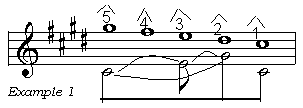
In the first phrase the prolongation of G sharp (against the tonic triad prolonged with neighbors) is immediately evident and needs no graphic schematizing to make it clear. As for the consequent phrase the ![]() and
and ![]() are stressed by octave registral shift. On this higher pitch they gain a special role in unfolding the Urlinie 5 of the whole piece. (A classical instrument of voice leading, the registral shift becomes a local paradigm that is meaningfully disseminated in further unfolding of events). Example 2 makes evident how close is the framework of the melody to abstract fundamental line and illustrates the fundamental wholeness of the first period. The lowered
are stressed by octave registral shift. On this higher pitch they gain a special role in unfolding the Urlinie 5 of the whole piece. (A classical instrument of voice leading, the registral shift becomes a local paradigm that is meaningfully disseminated in further unfolding of events). Example 2 makes evident how close is the framework of the melody to abstract fundamental line and illustrates the fundamental wholeness of the first period. The lowered ![]() , violating the normal paradigm of European music, implies a scent of Phrygian mode.
, violating the normal paradigm of European music, implies a scent of Phrygian mode.
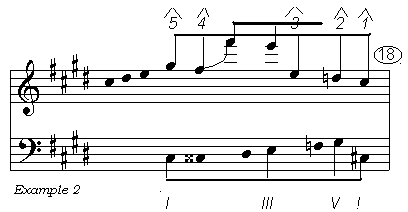
The Ursatz serves to structurally unify the piece as a whole and makes evident that it belongs to European classic tradition. But its composing out does not fully follow classic models. In the opening section of the B part leading to B-flat minor (enharmonically equals to A-sharp minor -- relative to parallel major) the vertical inversion of textural layers results in prolonging E by descending filling in the octave registral shift of an inner voice. (Example 3) The scheme displays the course of inner voices' motion prolonging the IV chord with neighbor and passing tones. The A in bass is related to C-sharp as a consonant skip (against E).
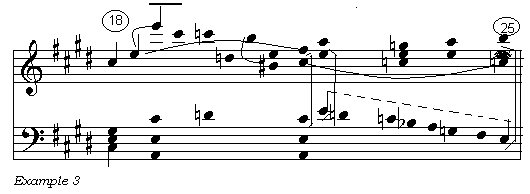
While, on the background, the role of the bass paradigm of T -- D -- T as general support remains unchallenged, the syntagmatics of the linear-contrapuntal nature of foreground texture determines somewhat 'virtual' manifestation of 'dotted' fundamental line. It is well evident when we examine the manner of prolonging ![]() of the fundamental line. Registral shifts 'split' the tone in the texture rendering it an equivalent role in fundamental voice leading irrespective of its pitch position. A situation comes out when its prolongation takes place not scrupulously 'in layers' (in classical manner) but rather roots in the laws of perception -- letting the ear to subconsciously hear the marked tones separated in time as functionally conjunct. Example 4 illustrates how the E remaining active in middleground voice leading is prolonged in several textural levels by means of neighbors distant in time. The scheme moreover reflects the 'mechanism' of how tonal (bass) and thematic reprise (melody) are separated in time.
of the fundamental line. Registral shifts 'split' the tone in the texture rendering it an equivalent role in fundamental voice leading irrespective of its pitch position. A situation comes out when its prolongation takes place not scrupulously 'in layers' (in classical manner) but rather roots in the laws of perception -- letting the ear to subconsciously hear the marked tones separated in time as functionally conjunct. Example 4 illustrates how the E remaining active in middleground voice leading is prolonged in several textural levels by means of neighbors distant in time. The scheme moreover reflects the 'mechanism' of how tonal (bass) and thematic reprise (melody) are separated in time.

The song-like basis generates the leading role of the melody and the way of its formation. Its basic principle of variants unfolding ascends to ethnomusical melodic techniques. It is worthwhile to trace some variant transformations, in order to grasp the sense of events. A variant of initial motive A (example 5), in the second phrase, gains the quality of a new motive B featured by dotted rhythm. In the next transformation of the initial motive two-measures figures bring forth rhythmic scale fragmentation. The sixteenths coming in m. 10 bear a shadow of irony, scherzo. This generic variant gains some autonomous role (C) The closing phrase of the consequent sentence, beyond its function of 'summing up after fragmentation' plays a generalizing role by molding together the elements C, B, and A.
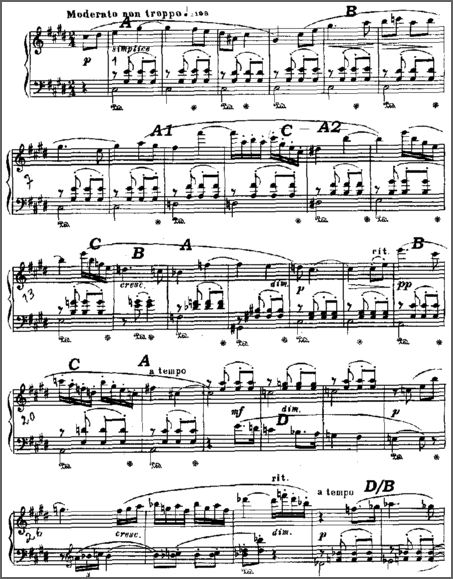
The middle part opens with variants B, C, A1. The rhythmic pace of the succeeding variant is reduced to dotted eighths accompanied with sixteenths. In this way another element (D) is derived. Gradually centrifugal process, i.e. further departure from invariant gains pace - from the stability of tonic harmony, from main key. The initial paradigm is exhausted in syntagmata of distant transformations of C element.
In the reprise's relatedness to the opening paradigm is restored. The texture of thematic restatement is a reminiscence of that of its initial announcement though embellished with a dotted rhythmic figure borrowed from the D variant. The initial development creating impulse, i.e. paradigmatically important, mode defining interval of perfect fifth (C-sharp -- G-sharp) is dissipated in syntagmatics of final occurrence of C variant. The fifth obtains 'centrifugal' quality, becoming a composed out augmented fifth embracing an ascending progression of whole tones.
In the piece process-structure dialectics is not univalent. As in any process, interaction of centrifugal and centripetal forces takes place. But their scaling in time and abyssal rhythm6 do not coincide with the foreground ternary paradigm. Temporal distribution of centrifugal and centripetal phases does not correspond with surface three part structure.
In the opening 25 measures, centrifugal process is gradually intensified: melody departs from initial invariant; variants undergo more and more profound transformations; harmony drives away from the stability of tonic. In mm 26-28 the process reaches its extreme point and direct connection of musical setting with the initial statement and early variants becomes hardly noticeable. For some time, the textural and rhythmic designs of accompaniment disappear, though they bear great unifying importance. At this point, the paradigmatic energy dissolved in syntagmatics of variant transformations comes to null point and, in the center of instability, symtagmatics becomes self contained.
Beginning second half of m. 29 centripetal process is switched on. It becomes apparent with restoration of the texture and rhythmic formula of accompaniment and I in bass, though not supported in simultanieties in upper voices of accompaniment. Contradiction comes out between tonal reprise and going on middle-part-like motion of harmonically unstable verticalities. The leading tone emerging in inner voices provokes the syntagmatically powerful interaction of forces aimed at opposite directions -- the energy of dominant bridge active in chords and the repose of attained tonic in bass. As for the melody, twice stated is the motive: a truncated variant of the theme, the molding of D and B. The centripetal motion reaches its goal in the beginning of recapitulation at the moment of paradigmatically strong statement of thematic variant very familiar to its initial statement -- in the main key -- enriched with dotted rhythmic figure D. So in contradiction with the ternary paradigm, the process of variants unfolding is syntagmatically sectioned in two phases -- centrifugal and centripetal. But there is a specific dialectics in the process: the second phase is featured by a new 'wave' -- from syntagmatics of middle-part-like non-thematic instability, indefiniteness to crystallizing of a new thematic variant in main key closely resembling the initial invariant. Again, centrifugal process is apparent in the closing phase, with paradigmatic energy of the theme dissipated (as mentioned above) in syntagmatics of fractionated transformations of the C motive leading 'nowhere', with the initial paradigmatic impulse of the ascending perfect fifth finally annihilated.
So we have witnessed that, on the very surface, the structure is defined by romantic ternary paradigm, while the process of unfolding thematic variants is distributed in two phases -- centrifugal and centripetal -- approximately equal in scale. But neither tree-part, nor two-phase structure find support in the behavior of the fundamental structure. There is no interruption (break) in fundamental structure's formation (as often is the case in structures of this kind). We are convinced that linear counterpoint brings forth some peculiarities of the process of FS making. Linear energy is more explicitly active in horizontal direction than, say, in composing out chords of main scale steps in classic paradigm A casual glance at the bass, the voice second in importance, (example 6) can discover that, paradigmatic in classic idiom, bass arpeggiation is completed in m. 18 closing the initial period. Though the tonic was, for a moment, 'negated' by the consonant skip to A all subsequent events are reducible to repeated closing V -- I formula.

Textural specificity serves to emboss the voice leading in the outer parts. Registral shifts (both instantaneous and filled in) result in rendering the melody sophisticated two level compound nature, making tones distant in time but stressed by higher pitch semantically conjunct. Thus the number of levels, layers in voice leading lessens and the influence of FS upon the process of form creation becomes more direct.
Viewing the whole work "from the height of a bird's flight" and penetrating, through its surface, into its inner layers, one can perceive the events defining its structure as shown in example 7.
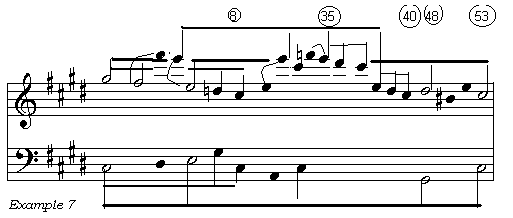
One can notice that prolongation of E in higher register begun in the first period dominates in voice leading. It persistently repeats the way of another type of fundamental structure - with ![]() -
- ![]() -
- ![]() line (example 8).
line (example 8).
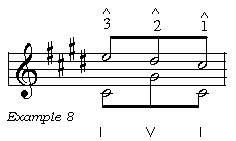
The E becomes conjugated with prolonged C-sharp (I) and follows its way according to the cited ![]() -
- ![]() FS (example 9).
FS (example 9).
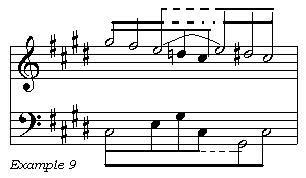
Thus we may witness the novelty of Shostakovich's interpretation of a classical paradigm. In this, at a glance, unpretentious piece we meet with syntagmatics on the level of abyssal paradigm: one paradigm of FS, under the pressure of special syntagmatic role of the E, outgrows into another. The immanent sense of the piece is expressed in the formation of this "modulating" fundamental structure, defining the marvelous unity and coherence of the work, so abundant with intricate details.
Email address:boriplot@vsptus.ru
FOOTNOTES
(1) L. Hakopian. "Analyzing abyssal structure of music text". Moscow. 1995 (in Russian)
Back to text
(2) We understand syntagmatics as relations among elements adjacent in the text, while paradigmatics is understood as relation among elements displaying some kind of kinship in some kind of parameters important for given system of symbols. (Ibid. p. 8)
Back to text
(3) As syntagmatically strong we consider the position of an element whose sense is defined mainly by the momentum of unfolding text, high extent of its coherence -- understood, in this case, rather in 'formally mechanical' way. (Ibid. p. 8)
Back to text
(4) An element is considered to occupy a paradigmatically strong position in case when it represents the class of homogeneous elements unified by common signs, i.e. a paradigm. To express the matter in a simpler way, paradigmatically strong position is determined by the extent of the element's 'recognizability', its associative potential, recognizing in it some origin unifying it with other analogous elements. (Ibid. p. 8-9)
Back to text
(5) "The background in music is represented by a contrapuntal structure which I have designated the fundamental structure. Fundamental line is the name which I have given to the upper voice of the fundamental structure. It unfolds a chord horizontally while the counterpointing lower voice effects an arpeggiation of this chord through the upper fifth." Heinrich Schenker. Free Composition (Der freie Satz). Translated and edited by Ernst Oster. Schirmer Books. New York p. 4.
Back to text
(6) The rhythm of fundamental structure should be understood as its characteristics determining the distribution of paradigmatic and syntagmatic positions of elements constituting the foreground structure. The main difference between rhythm of fundamental and foreground structures consists in that the first is continuous while the latter bears discrete character. (Ibid. p. 88)
Back to text